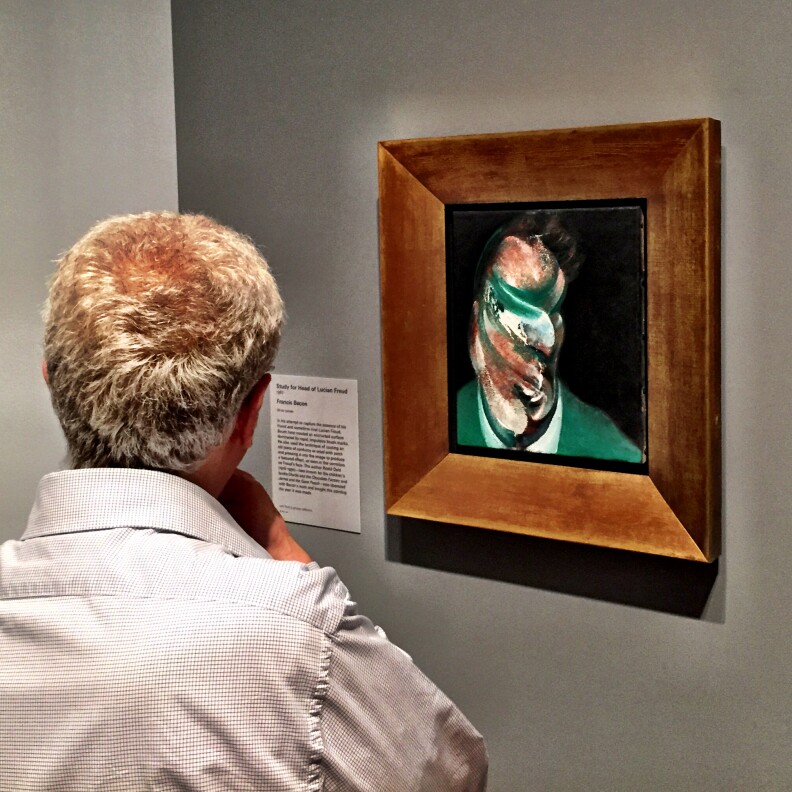Off-Ramp commentator Marc Haefele reviews "Blast! Modernist Painting in Britain, 1900-1940," at the Huntington Gallery through November 12. "London Calling" is at the Getty Center through November 13.
In England in the decade after World War 2, a third of the housing was bombed out; shops were empty. Food and even clothing were tightly rationed. As the old Empire vanished into thin air, the nation hovered on the edge of economic collapse. But from this stressed, sad, grayed-out culture came an unprecedented outpouring of great art.
The Getty Museum just opened a new exhibit called “London Calling,” featuring six artists from England’s post war era. And across the county, the Huntington has a new show called “Blast," which showcases a dozen pictures by predecessors, mentors, and teachers of those six “London” artists.

The Getty’s display offers more spectacle, and of course it includes Freud and Bacon, the two most famous British artists of our time. On the Getty’s streetlight posters you see Lucien Freud’s “Girl with a Kitten”— the cat somehow content in a stranglehold, the girl’s attention diverted into the middle distance. The geometry is loose, but Freud’s attention to detail is achingly fastidious. 10 years later, these aspects reverse—Freud’s fussiness is now a studied blotchiness, the shapes more massive and real, as he reaches toward the incredible physicality and presence of his last great nudes.
Francis Bacon spoke of his art as “sensation without the boredom of its conveyance,” and many think he intended to shock and appall. The Bacons at the Getty are relatively sedate, stressing his mighty shaping technique, his figurative genius, his startling color sense.
There’s also R. B. Kitaj, who’s been called the greatest historical painter of our time. He’s almost blissfully figurative with his wedding, his refugees; his tributes to the murdered Rosa Luxemburg and Isaac Babel riding with the Red Cavalry; something like Chagall if he’d apprenticed with Breughel.
Frank Auerbach and Leon Kossoff -- still painting today in their 80s and 90s – are more expressionist, but still invoke the plain, battered surroundings of a weary metropolis. And Michael Andrews wrapped up his short career with pure landscape, pictures literally infused with the sand and dirt in his paintings.
Go see “London Calling” at the Getty first, then head to the Huntington, to see a dozen recently acquired or loaned prime British paintings from before World War 2, some of which strongly influenced the Getty painters.

There’s pioneering modernist David Bomberg, with whom both Auerbach and Kossoff studied. You can see in their work Bomberg’s bold use of layered paint and colors, and a leaning toward abstraction.

There’s Stanley Spencer, whose powerfully emotional work with its combining of plants, humans, and animals foreshadowed themes of Lucien Freud.
Walter Richard Sickert is represented by one of his placidly unsettling "ennui" studies. He’s the Godfather of most modern English painting, and in his later years revised his style in keeping with the younger generation he sometimes mentored.
There is the sardonic "Cubist Museum" of Wyndham Lewis, who carried the avant garde torch in British painting until he lost faith in modernism and found equal fame as a novelist.
And there’s a fine, subtle portrait by Gwen John, the only woman painter in either of these shows.
It’s 28 miles from the Getty to the Huntington, but you should make the trip to see “London Calling” and “Blast.” Together, they provide a rich, continuous century’s span of English figurative art we’ve seldom seen here.








